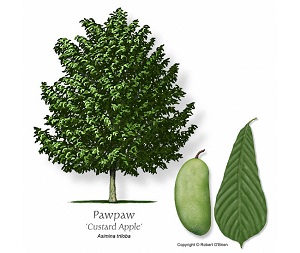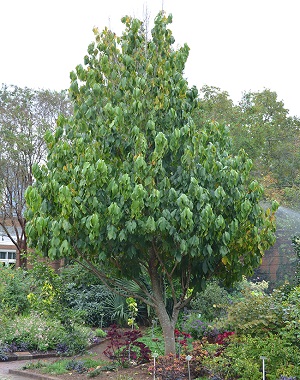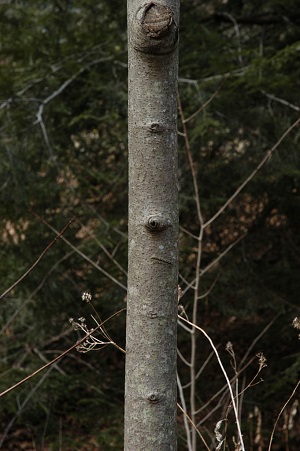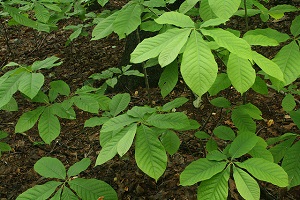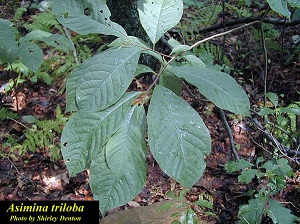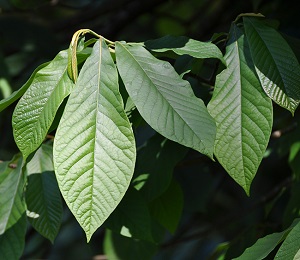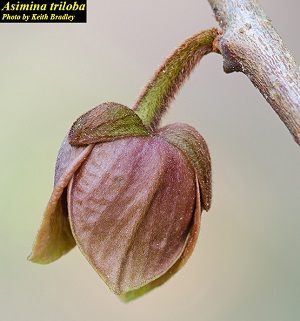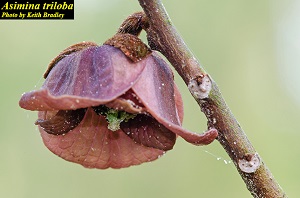| Pawpaw - Asimina triloba | ||||||||||||||||||
|---|---|---|---|---|---|---|---|---|---|---|---|---|---|---|---|---|---|---|
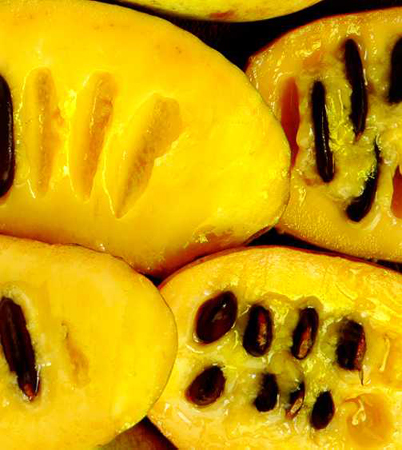 Fig. 1 Asimina triloba 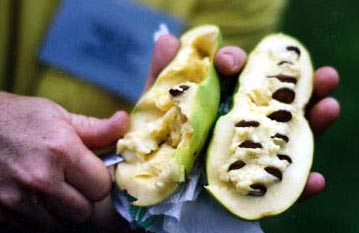 Fig. 2 A. triloba is often called wild banana or prairie banana because of its banana-like creamy texture and flavor 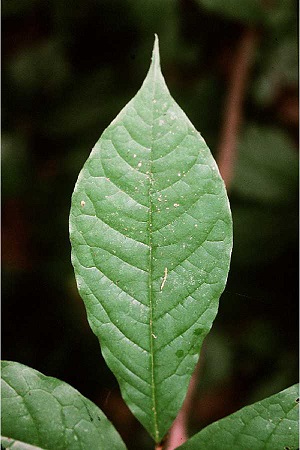 Fig. 3 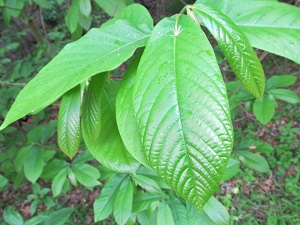 Fig. 4  Common pawpaw (A. triloba) leaf habit 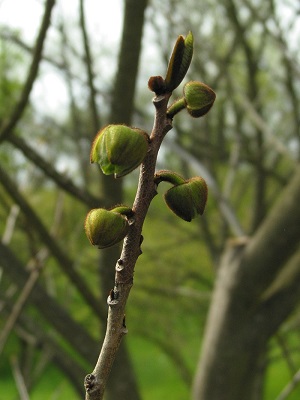 Fig. 7  Austrieb an einer Pawpaw (A. triloba) im Botanischen Garten Berlin  Fig. 8  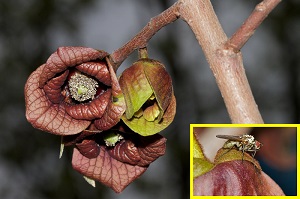 Fig. 9  Common pawpaw flowers and pollinator 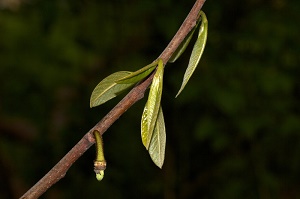 Fig. 13  A small developing fruit. It is still to early to tell whether this is fertile. It still may be dropped from the tree at this point.  Fig. 14  Pawpaw growing along the C&O canal 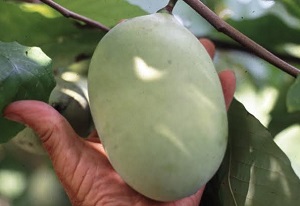 Fig. 15  Perfect pawpaw 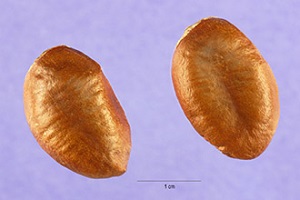 Fig. 16  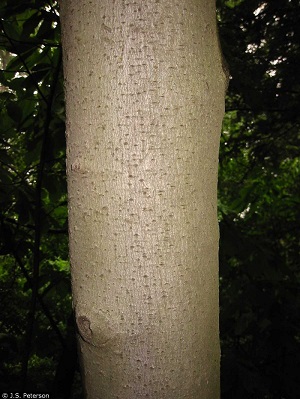 Fig. 17  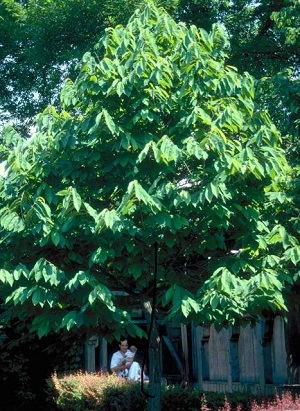 Fig. 18  Young A. triloba: Pawpaw
 Pawpaw, 'Custard Apple', A. tribola |
Scientific
name Asimina triloba (L.) Dunal Pronunciation uh-SIM-min-nuh try-LOE-buh 11 Common names Indiana banana, hoosier banana, poor man's banana, custard apple, dog banana, false banana, pawpaw apple, fetid shrub 10 Synonyms A. cuneata, Pityothamnus reticulatus Relatives A. incarna, A. longifolia, A. obovata, A. parviflora, A. pygmaea, A. reticulata, A. tetramera, A. X nashii Family Annonaceae Origin Native to North America USDA hardiness zones 5A-8B 11 Uses Edible landscaping; used as a screen or can be grown in a container as a specimen tree 10 Height 10-20 ft (3.5-6 m) Spread 15-20 ft (4.5-6 m) Crown Pyramidal shape; symmetrical; upright/erect 11 Plant habit Dwarf shrub or small tree Growth rate Moderate Trunk/bark/branches Droop as the tree grows; multiple trunks; no thorns Pruning requirement Other than removal of the 'suckers', it does not require pruning Leaves Deciduous; simple; alternate, oblong, obovate, 8-12 in. (20.3-30.5 cm), 4-8 in. (10.2- 20.3 cm) 11 Flowers Purple, inconspicuous, spring; protogynous, needs pollen from a genetically different tree Fruit 4-5 in. (10.16-12.7 cm) long; custard smooth white to apricot flesh Season July to September Light requirement Young trees require shade, part shade/part sun; full sun or dense shade but will have denser growth in the sun 11 Soil tolerances Needs acidic soil pH preference 4.2-5.5 Drought tolerance Moderate Aerosol salt tolerance Unknown Soil salt tolerance Unknown Cold tolerance Highly frost tolerant; -25 ° F (-31.7 °C) or lower; requires a minimum of 400 hours of winter chill and at least 160 frost-free days 4 Plant spacing 15-20 ft (4.5- 6 m) Roots Tap root makes it difficult to transplant Invasive potential * Little if any Pest resistance No pests or diseases are of major concern Known hazard Some people have a very severe allergic reaction to pawpaws 6 Fruit/leaves a litter problem 11 Reading Material Asimina triloba: Pawpaw, University of Florida pdf Pawpaw: A "Tropical" Fruit for Temperate Climates, ATTRA National Center for Appropriate Technology pdf Pawpaw (Asimina triloba): A "Tropical" Fruit for Temperate Climates, New Crops, Purdue University The Challenge of Pawpaws in the Subtropics, Tropical Fruit News, RFCI Pawpaw, New Crop FactSHEET, Purdue University Pawpaw Plant Guide, USDA Natural Resources Conservation Service pdf This plant is not recommended for south Florida "I came across your website which is really a wonderful source of information on the pawpaw. I have not been able to find information on a specific cultivar that would grow in our area but I have heard from Har Mahdeem that it is his favorite annona; I assume he grows them on the East Coast. If you could share any information on pawpaws that we could grow in Southwest Florida, I would be most appreciative." Liette "In answer to your question: Asimina triloba will not survive in your climate. It is too far south for it; too hot w/ intense sun in the summer; too little chilling hours in the winter. I have only heard of failure with A. triloba south of Ocala. It is true that pawpaw is a favorite annona of Har Mahdeem but I did not see him growing it when I visited. Of course, that was many years ago." Neal Peterson (April 2011) Neal Peterson's Breeding Program The History of the Peterson Pawpaws The Pawpaw and Its Relatives, Tropical Fruit News, RFCI Pawpaws are Possible in Florida, Tropical Fruit News, RFCI Origin The pawpaw is the only temperate member of the tropical Annonaceae family and is the largest tree fruit native to the United States. Pawpaws grow wild in the rich, mesic hardwood forests of 25 states in the eastern United States ranging from northern Florida to southern Ontario (Canada) and as far west as eastern Nebraska. Pawpaws flourish in the deep, rich fertile soils of river-bottom lands where they grow as understory trees or thicket-shrubs. In addition to the tropical Annona relatives, there are eight members of the Asimina genus that are native to the extreme southeastern states of Florida and Georgia. There are eight members of the Asimina genus that are native to the extreme southeastern states of Florida and Georgia. These include A. incana (flag pawpaw), A. longifolia, A. obovata, A. parviflora (dwarf pawpaw), A. pygmaea, A. reticulata, A. tetramera (opossum pawpaw), and A. X nashii. 3 Description The Pawpaw is one of this country's most over-looked fruits. Native to most parts of the United States, the Pawpaw thrives with little or no care. In sunny locations pawpaw trees typically assume a pyramidal habit, straight trunk and lush, dark green, long, drooping leaves that turn gold and brown in color during the fall. 3
Pawpaw Description and Nutritional Information, Kentucky State University Extension Leaves The drooping, pear-shaped leaves are alternate, from 10 to 30 cm long, with smooth margins and pointed tips. The leaves are coated with fine whitish hairs on the upper surface with rustycolored hairs on the under-side. Leaves are aromatic, with a smell reminiscent of bell pepper. The deciduous leaves turn bright yellow before dropping in the fall. 10
Flowers Inconspicuous but interesting flowers (4 to 5cm in diameter) with 3 sepals, are green upon opening and turn to dark purple or maroon in color. From 1 to 4 flowers grow in the leaf axils before leafing, usually in April or May. The six velvety petals (2cm-2.5cm long) are stiff and curl slightly backwards. 10
Fruit Yellowish green to brown, cylindrical, mango-shaped fruits are 7-16 cm long and grow solitarily or 2 to 4 together. Fruits have a thin skin, which contain a yellow custard-like pulp that is said to taste like papaya. Some varieties contain a whitish-green pulp that is less flavorful. Fruits contain several flat 2cm long seeds. 10 The fruit of the pawpaw tree has a unique and complex flavor, resembling that of tropical fruit, and a pronounced aroma that is fruity and floral. High quality pawpaws compare favorably to pears, peaches, bananas, and mangos. 2 Pawpaws are very nutritious fruits. They are high in vitamin C, magnesium, iron, copper, and manganese. They are a good source of potassium and several essential amino acids, and they also contain significant amounts of riboflavin, niacin, calcium, phosphorus, and zinc. Pawpaws contain these nutrients in amounts that are generally about the same as or greater than those found in bananas, apples, or oranges. 7 Varieties At least four cultivars of pawpaw are available commercially in the United States: Overleese, Taytwo, Mary (Foos) Johnson, and Sunflower. At least another six cultivars exist that may be obtained through amateur organizations such as the North American Fruit Explorers and Northern Nut Growers Association: Mitchell, Silver Creek, Rebecca’s Gold, Wilson, Taylor, and Davis. Known cultivars grafted onto seedling rootstocks offer the best possibility of obtaining good fruit quality. 2 Varieties Page Pawpaw Variety Development: A History and Future Prospects, Neal R. Peterson pdf Harvesting Ripe pawpaw fruits are easily picked, yielding to a gentle tug. Shaking the tree will make them fall off. (If you try this, don’t stand under the fruit clusters, and don’t say we didn’t warn you.) Ripeness can also be gauged by squeezing gently, as you would judge a peach. The flesh should be soft, and the fruit should have a strong, pleasant aroma. The skin color of ripe fruit on the tree ranges from green to yellow, and dark flecks may appear, as on bananas. The skin of picked or fallen fruit may darken to brown or black. 7 Pollination Pollination is the major limitation to pawpaw fruit set. The flowers are “protogynous,” meaning that the stigma (the female receptive organ) ripens before the pollen does and is no longer receptive when the pollen is shed. Thus, the flower’s design insures that the flower will not pollinate itself. In addition, pawpaw trees are usually self-incompatible, requiring pollen from a genetically different tree in order to be fertilized. Two or more genotypes are required for pollination and fruit set. Finally, the natural pollinators of the pawpaw (various species of flies and beetles) are neither efficient nor dependable. Although it requires a little extra labor, hand pollination can be well worth the effort. 2 Propagation Seed should be removed from the fruit, cleaned, and placed in a polyethylene bag with damp sphagnum moss and should not be allowed to dry out. Seed should be stratified at 2° to 4°C for 60 to 100 days before planting (Thomson 1982; USDA 1948). Seed should be planted about 2.5 cm deep. The depth of Rootrainer books, commonly used in the propagation of forest trees, is especially desirable because of pawpaw's long taproot. Once seedlings reach a height of 10 to 20 cm they can be transplanted into tall pots (10 x 10 x 36 cm) with partially open bottoms and placed on greenhouse benches. Taproots growing out the bottom of these pots are "air-pruned." The most reliable and commonly used method of vegetative propagation is chip-budding. Root cuttings have been used successfully (USDA 1948), but softwood propagation methods (those using cuttings from soft, succulent, new growth) have not been satisfactorily developed. 1 Planting Seedlings should be started in pots for several reasons. First, pawpaw seedlings are reported to be sensitive to ultraviolet light (Peterson 1991). However, following a season of growth in partial shade, they no longer seem to be affected by direct sunlight. Rather, they grow and produce better in full sun (Wilson and Schemske 1980). Second, pawpaws have a reputation of being difficult to transplant and this difficulty increases with plant size. Plants grown in containers to approximately 1 m in height before transplanting largely circumvent these problems. Finally, plants may reach bearing size sooner when grown in containers before transplanting to the field, since optimal growing conditions are often more easily provided to container-grown plants. 1 Growing Pawpaws, Purdue University Extension pdf Pawpaw Planting Guide, Kentucky State University Extension Transplanting The pawpaw is very difficult to transplant. It would seem natural to propagate a clone by transplanting root suckers, since pawpaws commonly sucker from the roots, but in practice this is extremely difficult and usually ends in failure. Seedling trees, on the other hand, have been successfully transplanted. Experience has shown that to be successful, seedlings should be transplanted in the spring, at the time that new growth commences or soon after. If many roots are damaged, it may be desirable to prune the top to bring it into balance with the remaining roots. While for many species a bare-root tree is sufficient for transplanting, it is not preferred for pawpaw. 2 Pruning This plant spreads quickly by suckers to form a “pawpaw patch.” Remove suckers as they form if a tree form is desired. Sucker formation slows as the tree develops. Other than control of suckers, the plants do not require pruning. 10 Fertilizing Look for a fertilizer meant for acid loving trees and make sure the fertilizer contains iron, zinc, manganese, magnesium, molybdenum, copper and boron. These minor elements are very important to plants and most soils are low in these elements. 5 Irrigation Extra care should be given trees for the first two years to promote growth as the root system establishes itself. Keep the plants well watered and partially shaded for the first year or two. Thereafter, growth accelerates and trees require little care. 2 Pest Page Food Uses Delicious banana-like flavor is awesome. The fruit is eaten fresh or used in salads and for making custard pies and preserves. Used like a banana, raw or cooked, as in baked desserts, ice cream, pastries, or in making beer. Don’t eat the skin and don’t eat the seeds. Chewed seeds will cause digestive problems, whole seed usually pass through. Try only a very little at first. 6 Pawpaws in the Kitchen, Tropical Fruit News, RFCI Medicinal Properties ** The leaves contain anticarcinogens. 10 Other Uses The twigs and leaves contain extracts that have insecticidal properties. Opossum, raccoon, foxes and squirrels eat the fruits. Larvae of the lovely Zebra Swallowtail butterfly (Eurytides marcellus) feed exclusively on the leaves. 10 General The genus name Asimina is adapted from the Native American (probably Miami-Illinois) name assimin or rassimin through the French colonial asiminier. The epithet triloba in the species' scientific name refers to the flowers' three-lobed calices and doubly three-lobed corollas,the shape not unlike a tricorne hat. 9 The common name of this species is variously spelled pawpaw, paw paw, paw-paw, and papaw. It probably derives from the Spanish papaya, an American tropical fruit (Carica papaya) sometimes also called "papaw". 9 Pawpaw, see papaw (n.) 1620s, variant of papaya (q.v.), used from 1760 to designate the papaw tree. 8 Fig. 22  Fig. 22. Pawpaw distribution map, wild populations Further Reading Pawpaw, Just Fruits and Exotics nursery Pawpaw, California Rare Fruit Growers Pawpaw Picking Up is Rare, Eat the Weeds The Asimoya Asimina triloba, Archives of the Rare Fruit Council of Australia Peterson's Pawpaw ext. link Kentuky State University Pawpaw Website ext. link Pawpaw Botanical Art List of Growers and Vendors |
|||||||||||||||||
| Bibliography 1 Callaway, M. Brett. "Pawpaw (Asimina triloba): A "Tropical" Fruit for Temperate Climates." New Crops, Edited by J. Janick and, J. E. Simon, 1993, NewCROPTM, hort.purdue.edu/newcrop/proceedings1993/V2-505.html. Accessed 22 Feb. 2015, 28 Apr. 2019. 2 Bordelon, Bruce. "Growing Pawpaws." Purdue University Cooperative Extension Service, Reviewed Apr. 2001, hort.purdue.edu. Accessed 23 Feb. 2015. 3 Layne, Desmond R. "Pawpaw." New Crop FactSHEET, NewCROPTM, hort.purdue.edu/newcrop/CropFactSheets/pawpaw.html. Accessed 3 Apr. 2015, 28 Apr. 2019. 4 "Pawpaw." California Rare Fruit Growers, 1969-1989, crfg.org. Accessed 23 Feb. 2015. 5 "Pawpaw." Just Fruit and Exotics, justfruitsandexotics.com. Accessed 26 Feb. 2015. 6 Deane, Green. "Pawpaw Picking Up is Rare." Eat the Weeds and other things, too, eattheweeds.com. Accessed 26 Jan. 2015. 7 Jones, Snake C., et al. "Pawpaw Description and Nutritional Information." Pawpaw Research Project, Community Research Service, Atwood Research Facility, Frankfort, KY 40601-2355 Updated 9 Jan. 2009,kysu.edu. Accessed 23 Feb. 2015. 8 "Pawpaw, papaw." Online Etymology Dictionary, etymonline.com. Accessed 11 Apr. 2015. 9 "Asimina triloba." Wikipedia, wikipedia.org, Accessed 11 Apr. 2015. 10 Immel, Diana L. "Pawoaw, Asimina triloba (L.) Dunal." USDA, NRCS, National Plant Data Center, c/o Environmental Horticulture Dept., University of California, Davis, California, Edited 21 May 2001, 29 Apr. 2003, 31 May 2006, plants.usda.gov. Accessed 29 Dec. 2016. 11 Gilman, Edward F., and Dennis G. Watson. "Asimina triloba: Pawpaw." Environmental Horticulture Dept., UF/IFAS Extension, TENH245, Original pub. Nov. 1993, Revised Dec. 2006, Reviewed Feb. 2014, AskIFAS, edis.ifas.ufl.edu. Accessed 29 Dec. 2016. Photographs Fig. 1 Manuel.conde. "Pawpaw fruit." Wikimedia Commons, commons.wikimedia.org. Accessed 23 Feb. 2015. Fig. 2 Clarknova. "Asimina triloba is often called wild banana or prairie banana because of its banana-like creamy texture and flavor." Red Fern Farm in Wapello, Iowa, 2005, Wikimedia Commons, commons.wikimedia.org. Accessed 29 Dec. 2016. Fig. 3 Mohlenbrock, Robert H. "Asimina triloba." USDA, NRCS, The PLANTS Database, National Plant Data Team, Greensboro, NC 27401-4901 USA, 1991, plantatlas.usf.edu. Accessed 23 Feb. 2015. Fig. 4 Anderson, James. "Common pawpaw (Asimina triloba)." Flickr, 2011, www.flickr.com. Accessed 28 Feb. 2015. Fig. 5 Denton, Sherley. "Asimina triloba. Asimina triloba." Atlas of Florida Vascular Plants, Institute for Systematic Botany, University of South Florida, Tampa, plantatlas.usf.edu. Accessed 29 Dec. 2016. Fig. 6,19 Mark, W., and J. Reimer. "Pawpaw, Asimina Triloba." Urban Forest Ecosystems Institute, selectree.calpoly.edu. Accessed 26 Feb. 2015. Fig. 7 Gummi, Robert. "Austrieb an einer Pawpaw (Asimina triloba) im Botanischen Garten Berlin." Wikimedia Commons, 2005, Public domain at the German Wikipedia project, commons.wikimedia.org. Accessed 29 Dec. 2016. Fig. 8,10,11 Bradley, Keith. "Asimina triloba." Atlas of Florida Vascular Plants, Institute for Systematic Botany, University of South Florida, Tampa, plantatlas.usf.edu. Accessed 29 Dec. 2016. Fig. 9 NatureServe, Wolf, Alan. "Common pawpaw flowers and pollinator." Flickr, 2010, www.flickr.com. Accessed 28 Feb. 2015. Fig. 12 Kenraiz, Krzysztof Ziarnek. "Asimina triloba flowers." Glinna Arboretum near Szczecin (NW Poland), 2010,(GFDL), commons.wikimedia.org. Accessed 23 Feb. 2015. Fig. 13 Wolf, Alan. "A small developing fruit. It is still to early to tell whether this is fertile. It still may be dropped from the tree at this point." Flickr, 2010, (CC BY-NC 2.0), www.flickr.com. Accessed 30 Dec. 2016. Fig. 14 Crain, Alice. "Pawpaw growing along the C&O canal." Flickr, 2014, www.flickr.com. Accessed 28 Feb. 2015. Fig. 15,17 Peterson, Neal. "Asimina triloba." Peterson Pawpaws, www.petersonpawpa.com. Accessed 11 Apr. 2015. Fig. 16 Hurst, Steve. "Asimina triloba." USDA, NRCS, The PLANTS Database, National Plant Data Team, Greensboro, NC 27401-4901 USA, 1991, plantatlas.usf.edu. Accessed 23 Feb. 2015. Fig. 18 Gilman, Edward F. "Young Asimina triloba: Pawpaw." University of Florida, AskIFAS, edis.ifas.ufl.edu. Accessed 29 Dec. 2016. Fig. 20 Celerylady. "Pawpaw tree." Asheville Botanical Gardens in wintertime, 2011, Wikimedia Commons, commons.wikimedia.org. Accessed 23 Feb. 2015. Fig. 21 dogtooth77. "Asimina triloba close-up." Flickr, 2008, www.flickr.com.Accessed 28 Feb. 2015. Fig. 22 "Distribution Map of Asimina tribola." Atlas of Florida Vascular Plants, Institute for Systematic Botany, University of South Florida, Tampa, plantatlas.usf.edu. Accessed 22 Feb. 2015. Fig. 23 O'Brian, Robert. "Asimina triloba." Urban Forest Ecosystems Institute, selectree.calpoly.edu. Accessed 26 Feb. 2015. * UF/IFAS Assessment of Non-native Plants in Florida's Natural Areas ** Information provided is not intended to be used as a guide for treatment of medical conditions. Published 2013 LR. Last update 4 Jan. 2024 LR |
||||||||||||||||||
